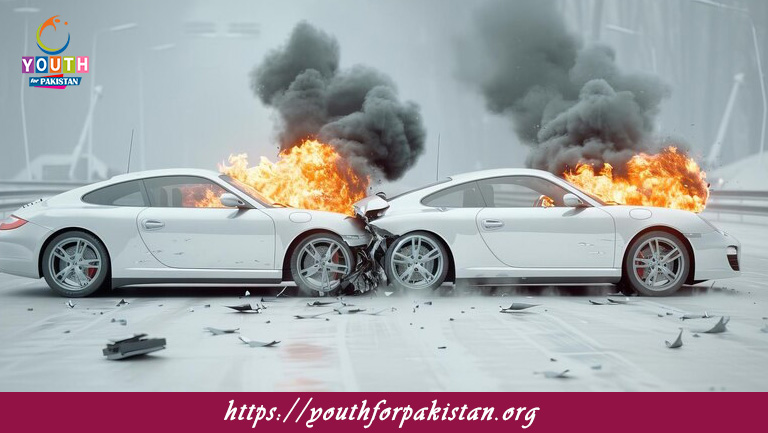Collision MDCAT MCQs with Answers

Welcome to the Collision MDCAT MCQs with Answers. In this post, we have shared Collision Multiple Choice Questions and Answers for PMC MDCAT 2024. Each question in MDCAT Physics offers a chance to enhance your knowledge regarding Collision MCQs in this MDCAT Online Test.
Collision MDCAT MCQs Test Preparations
In a perfectly elastic collision, which of the following quantities is conserved?
a) Kinetic energy
b) Momentum
c) Both kinetic energy and momentum
d) Neither kinetic energy nor momentum
In an inelastic collision, which quantity is conserved?
a) Kinetic energy
b) Momentum
c) Both kinetic energy and momentum
d) Neither kinetic energy nor momentum
When two objects collide and stick together, the collision is called:
a) Perfectly elastic
b) Perfectly inelastic
c) Partially elastic
d) Non-collisional
During a collision, if no external forces are present, the total momentum of the system:
a) Is conserved
b) Increases
c) Decreases
d) Becomes zero
In a collision between two cars, if the total momentum before the collision is 100 kg·m/s, the total momentum after the collision:
a) Is less than 100 kg·m/s
b) Is greater than 100 kg·m/s
c) Remains 100 kg·m/s
d) Becomes zero
For a perfectly elastic collision, the relative velocity of approach is equal to:
a) The relative velocity of separation
b) The sum of the velocities
c) The difference of the velocities
d) Zero
In a perfectly inelastic collision, the maximum kinetic energy is:
a) Conserved
b) Lost
c) Increased
d) Unchanged
A collision in which two objects collide and bounce off each other is called:
a) Perfectly inelastic
b) Partially elastic
c) Perfectly elastic
d) Non-elastic
When two billiard balls collide, if one ball is stationary, the momentum of the stationary ball:
a) Is zero before and after the collision
b) Is zero before the collision and changes after
c) Is equal before and after the collision
d) Changes but cannot be determined
During a collision, if the total kinetic energy is not conserved, the collision is:
a) Elastic
b) Perfectly elastic
c) Inelastic
d) Non-collisional
In a head-on collision between two vehicles, if they stick together, the collision is:
a) Elastic
b) Perfectly elastic
c) Inelastic
d) Perfectly inelastic
For a two-dimensional collision, the conservation of momentum applies:
a) Only in one direction
b) Only if the collision is elastic
c) In both directions (x and y)
d) In neither direction
If two objects collide and their velocities are exchanged, the collision is:
a) Inelastic
b) Elastic
c) Perfectly inelastic
d) Non-elastic
When two objects collide elastically, which quantity is always conserved?
a) Kinetic energy
b) Momentum
c) Both kinetic energy and momentum
d) Neither kinetic energy nor momentum
A collision in which kinetic energy is not conserved but momentum is conserved is called:
a) Elastic
b) Perfectly elastic
c) Inelastic
d) Perfectly inelastic
In a collision, if two objects of equal mass collide and stick together, their final velocity is:
a) The average of their initial velocities
b) The sum of their initial velocities
c) The difference of their initial velocities
d) Zero
The impulse experienced by an object during a collision is equal to:
a) The change in momentum
b) The change in kinetic energy
c) The force applied
d) The distance traveled
If two objects collide and one object is much more massive than the other, the smaller object:
a) Experiences a greater change in velocity
b) Experiences a smaller change in velocity
c) Experiences no change in velocity
d) Has the same change in velocity as the larger object
In a collision where momentum is conserved, but kinetic energy is not, the collision is:
a) Elastic
b) Perfectly elastic
c) Inelastic
d) Perfectly inelastic
When analyzing collisions, the concept of impulse is used to determine:
a) The change in momentum
b) The change in velocity
c) The change in force
d) The energy lost
A collision where the objects do not stick together but lose some kinetic energy is called:
a) Perfectly elastic
b) Perfectly inelastic
c) Partially elastic
d) Non-elastic
During a collision, if the total momentum of a system of particles remains constant, then:
a) The collision is perfectly elastic
b) The collision is inelastic
c) The collision could be either elastic or inelastic
d) The system has external forces acting on it
The final velocity of two colliding objects can be calculated using:
a) The principle of conservation of energy
b) The principle of conservation of momentum
c) The conservation of temperature
d) The conservation of mass
A collision in which two objects rebound off each other with no loss in total kinetic energy is:
a) Perfectly inelastic
b) Partially inelastic
c) Perfectly elastic
d) Non-elastic
If a fast-moving car collides with a stationary car and they stick together, the system’s momentum:
a) Is not conserved
b) Is conserved
c) Decreases
d) Increases
The change in momentum of an object during a collision is equal to:
a) The change in its velocity
b) The force applied to it
c) The impulse experienced by it
d) The change in its energy
In a collision between two cars, if one car is initially at rest, the total momentum before the collision is:
a) Zero
b) Equal to the momentum of the moving car
c) Equal to the combined momentum after the collision
d) Unchanged by the collision
If a collision results in the combined mass of the colliding objects moving with a common velocity, the collision is:
a) Elastic
b) Perfectly elastic
c) Inelastic
d) Perfectly inelastic
In a two-dimensional collision, the conservation of momentum applies:
a) Only in the x-direction
b) Only in the y-direction
c) In both x and y directions
d) Only if the collision is elastic
When two objects collide and bounce off each other without any loss of kinetic energy, the collision is:
a) Perfectly inelastic
b) Inelastic
c) Elastic
d) Non-collisional
During an inelastic collision, some of the initial kinetic energy is transformed into:
a) Potential energy
b) Thermal energy
c) Gravitational energy
d) Electrical energy
In a collision involving two objects, if the total momentum before and after the collision is the same, it implies that:
a) Kinetic energy is conserved
b) The collision is elastic
c) The collision is inelastic
d) Momentum is conserved
If two identical objects collide head-on with equal speeds and stick together, the final velocity of the combined mass is:
a) Equal to the initial speed
b) Half of the initial speed
c) Zero
d) Double the initial speed
In an explosion, if the total momentum of the fragments is considered, it:
a) Increases
b) Decreases
c) Remains constant
d) Becomes zero
During a collision between a small object and a large object, the smaller object typically:
a) Experiences a greater momentum change
b) Experiences a smaller momentum change
c) Experiences no momentum change
d) Has the same momentum change as the larger object
If a projectile explodes into two pieces in mid-air, the total momentum of the two pieces:
a) Increases
b) Decreases
c) Remains constant
d) Becomes zero
In a collision, the concept of impulse is used to determine:
a) The force applied over a time interval
b) The change in momentum
c) The change in kinetic energy
d) The energy loss
During an elastic collision, the kinetic energy of the system:
a) Is conserved
b) Is not conserved
c) Is transformed into potential energy
d) Becomes zero
In a perfectly inelastic collision, the colliding objects:
a) Separate after collision
b) Bounce off each other
c) Stick together
d) Have no change in momentum
When two objects collide and the system is closed, the total momentum of the system is:
a) Changed
b) Conserved
c) Increased
d) Decreased
If you are interested to enhance your knowledge regarding Physics, Chemistry, Computer, and Biology please click on the link of each category, you will be redirected to dedicated website for each category.





